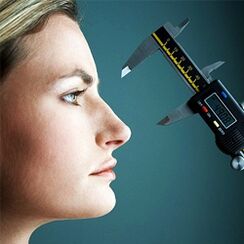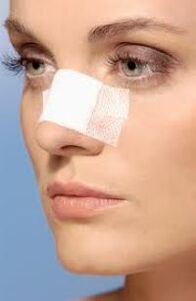The nose is the most spectacular part of the face, and its shape and general appearance determine a person’s perception by others. Many of us are dissatisfied with our noses: some don’t like the size or shape, others suffer from humps or too wide wings, and others want to strengthen the tip of the nose that stands up vigorously or, on the contrary, falls down. All of these problems are simply solved to the delight of patients with one of the most ancient plastic surgeries - rhinoplasty.
Rhinoplasty- surgery to correct (change) the shape or size of the nose in order to improve its appearance and to eliminate problems with nasal breathing and to create a psychologically comfortable state.
Types of rhinoplasty
Distinguish between aesthetic and reconstructive rhinoplasty.
The main goal of aesthetic rhinoplasty is to correct the "flaw" of nature by changing the shape or size of the nose, making the face appear more harmonious and attractive. Aesthetic rhinoplasty can be complete or superficial (partial).
A complete rhinoplasty is a plastic surgery in which the surgeon touches all the structural parts of the so-called outer nose: the bone tissue, the cartilage tissue, and the soft tissues. Such surgery is recommended for patients who want to reduce the length or width of the nose, change the shape of the saddle, and remove the hump.
Partial (or superficial) rhinoplasty is the operation of correcting (changing) the shape of the nose, where the surgeon confines himself to processing only a few external parts of the nose without affecting the bone tissue. Partial rhinoplasty is performed when it is necessary to correct the tip of the nose or reduce the wings, although full rhinoplasty may be needed to eliminate such problems - this is decided by the doctor after the examination and discussion with the patient.
Reconstructive rhinoplasty is primarily aimed at solving such a problem, for example, by eliminating breathing difficulties due to nasal septum curvature or turbine hypertrophy. Reconstructive rhinoplasty involves restoring the appearance of the nose, damaged (e. g. , "slipped to the side" due to a fracture), and partially or completely lost due to injury. This type of operation is used when it is necessary to correct the congenital deformity of the osteochondral skeleton of the nasal region. Sometimes, a plastic surgeon will have to "carve" a new sculpture literally, using auricular cartilage or rib cartilage (especially in severe cases), as well as artificial materials.
Often, the patient does not have to undergo surgery not so much for cosmetic and aesthetic purposes, but to restore normal breathing, which has been damaged due to deformity of the nasal septum received during the trauma. Post-traumatic surgery usually involves rhinoplasty and septoplasty (surgery to correct the nasal septum, the main purpose of which is to restore normal nasal breathing).
Preparation for rhinoplasty surgery

Before deciding on a surgery, the patient discusses with the plastic surgeon the future parameters and appearance of the nose, reveals exactly what the patient wants to achieve, and the end result is simulated with a computer. This approach helps to "try out" the patient's new face before surgery and to ensure that its new appearance does not violate the overall proportions of the face, and the shape of the nose blends harmoniously with all facial features.
It should also be borne in mind that rhinoplasty should not be performed if the patient has not reached the age of 17-18 years. This is due to the growth of the body and the formation of cartilage and skeleton, the consequences of the earlier age of rhinoplasty can be unpredictable. But it is advisable to use rhinoplasty at the earliest at the age of 21 - doctors say this is when the skeleton will eventually form.
Characteristics of nasal correction surgery
Rhinoplasty is recognized as one of the most difficult plastic surgeries: after all, it is important not only to change the nose and specify the desired size or shape, but also to disrupt the breathing of the nose. Therefore, such an operation should only be performed by an experienced professional who is already proven and has good patient judgment.
Rhinoplasty can be performed with both open and closed access. Open access from the outside involves an incision in a skin that will eventually become almost invisible. In the case of closed access, the surgical procedure is performed from the side of the nasal mucosa (through the nostrils) without external incisions and leaves no trace at all. Closed rhinoplasty is considered more difficult and requires the special skills of a plastic surgeon.
The type of access is determined directly at the consultation and depends on many factors: the shape of the nose, the characteristics of its structure, and the desired outcome. The operation to correct the size or shape of the nose is performed under local anesthesia or anesthesia. general anesthesia: the choice of anesthesia is influenced by the complexity of the surgical procedure and the duration of the proposed surgery. . . . In any case, the patient is completely relieved of the pain and does not feel any discomfort.
Postoperative period

Rhinoplasty is a serious surgical procedure that requires not only the professional approach of the doctor but also the responsibility of the patient during the rehabilitation period. The postoperative period is painless. Only for the first few days, a tampon that makes breathing difficult for the nose causes some discomfort to the patient.
A fixative plaster bandage is applied to the nose, which is removed from time to time for skin care, usually such a bandage is mandatory for 7-10 days. During this time, the primary edema usually disappears, with bruising and swelling under the eye disappearing. The remaining subcutaneous induration, almost invisible to others, disappears completely in the 6-8 month period. After this time, the end result of the rhinoplasty will be visible.
As a general rule, the patient is released the day after surgery, but remains under medical supervision and arrives at the clinic for examinations and dressings. The process of general healing after rhinoplasty surgery takes about a month, during which the patient is required to wear a special bandage in the nasal area as well as to limit physical activity and eliminate bad habits (smoking, alcohol consumption).
A patient undergoing rhinoplasty should undergo mandatory plastic surgery at 3, 6, and 12 months after surgery.
Contraindications to rhinoplasty
An experienced plastic surgeon is unwilling to perform surgery if the patient has the following conditions:
- cardiovascular diseases;
- coagulation disorders;
- chronic diseases of the liver and kidneys in the acute stage;
- oncological diseases;
- infectious diseases;
- mental illness.
Of course, rhinoplasty is a serious step in the life of a person who dreams of changing his nose and at the same time his life. But many of us understand perfectly well: if we can "disguise" some - even significant - figure flaws, or even turn them into benefits with the help of clothes, the ugly nose is the first thing others pay attention to when they look at a person’s face. And if this nose is too big or humpy, such a "sight" can not be hidden in any way, it always spoils the look and feel. Therefore, sometimes you have to decide on a surgical procedure and correct the shape or size of your nose as if you are suffering for the rest of your life, sighing every time you look in the mirror.






















